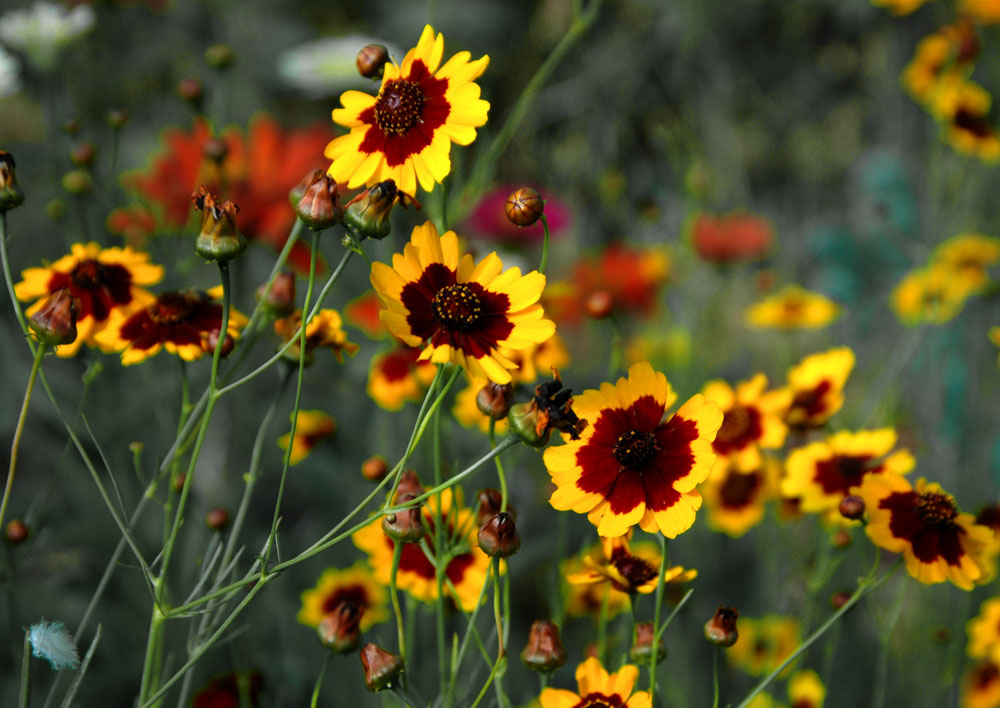
By Sarah Browning, Extension Educator in Lancaster County
Inspired by a similar national event, Nebraska Wildflower Week is a celebration of wildflowers and native plants in the wild and in the landscape through events and activities across the state. It will be observed in early June when many of Nebraska’s prairies and gardens are at their prime.
Nebraska Statewide Arboretum serves as coordinator for Wildflower Week activities, bringing together organizations and individuals across the state that recognize the value of wildflowers — not only for their beauty but also for what they imply and symbolize.
“Where wildflowers are thriving, it is a sign that the environment is healthy,” said Bob Henrickson, whose nursery production work with the Arboretum concentrates on native and regionally appropriate plants.
BOB’S TOP TEN WILDFLOWERS
Beardtongue, Penstemon grandiflorus — There are over 200 species of Penstemon, with nearly 24 native to the Great Plains. Ours are upright, multi-stemmed perennials, growing from 2–3 feet tall. Flowers are shaped like snapdragons, in shades of pink, red, blue, purple or white, arranged in upright spikes. Prefers full sun and well-drained soil. Looks great planted in masses.
Compass plant, Silphium laciniatum — This classic prairie plant is a relative of the sunflower, with many large bright yellow flowers in late summer. The large, 15-inch coarse, oak-like leaves align themselves in a north-south direction, then it sends up a 4–7 foot flowering stalk in summer. Also called "century plant" because of its ability to survive for decades. Best for larger gardens where the prairie sky is your background. Can grow to 3 feet wide and 7 feet high.
Leadplant, Amorpha canescens — A Nebraska native that attracts butterflies, it has showy, blue–purple flowers with gold anthers that rise above silvery green foliage. Prefers well–drained soil in full sun, but also tolerates poor, dry soil. Grows 2 feet high and wide.
Prairie larkspur, Delphinium virescens — Native perennial of moist, tallgrass prairies that grows to 3 feet tall. Distinctive flowers in May–June have five white petal-like sepals with purplish-brown spot and a long spur.
Plains coreopsis, Coreopsis tinctoria — A native annual that flowers from June to September. Flashy yellow flowers with red centers and brown center disks are produced on fairly large branched plants. Grows from 1–3 feet tall and prefers dry prairies or open woodlands.
Purple poppy mallow, Callirhoe involucrata — This tough native is often grown as a groundcover or allowed to weave among taller perennials. Its stems lie close to the ground, but do not root, growing out to 4 feet each year from a bulb-like corm that gets as big as a turnip. Bright purple cup-shaped flowers bloom profusely in early summer among the attractive, cut-leaf foliage.
Prairie coneflower, Echinacea pallida — Flashy flowerheads have pale pink drooping petals around a dark, dome-shaped disk. Grows 1–3 feet tall in moist to dry upland prairies. Stout, unbranched stems are covered with coarse, stiff hairs. Seedheads remain through winter.
Yellow coneflower, Ratibida columnifera — This bushy 2-foot tall native prairie plant is extremely drought-tolerant. In late summer, the top of the plant is covered with flowers of bright yellow petals drooping around a central cone. Prefers a hot, sunny site and well-drained soils.
Prairie phlox, Phlox pilosa — Native perennial with rounded clusters of deep pink to magenta flowers blooms May–July. Grows from 1–2 feet tall in dry to moist, well-drained prairies. Narrow leaves can be up to 4-inches long.
Spiderwort, Tradescantia ohioensis — Clump-forming, multi-stemmed perennials with arching, grass-like leaves. Produces showy clusters of flowers in late spring and early summer. Colors range from various shades of blue to pink, rose, purple and white. Spiderworts native to the Great Plains can tolerate full sun and dry conditions.
****************************************
UPCOMING EVENTS
Opportunities for wildflower enthusiasts across the state include guided tours, presentations on wildflower plantings, exhibits, prairie runs and much more.
• All month-long in June, wildflower activities and hikes at Mahoney State Park, every Wednesday from 1:30–2 p.m. Meet in front of the Activity Center. Kelly Ekue, 402-332-5022, kelly.ekue@nebraska.gov.
• Thursday, June 8, in Lincoln. “Wildflower Walkabout” 10–11 a.m. at Pioneers Park Nature Center. $5 per person, register by June 7. For more information, call 402-441-7895 or email naturecenter@lincoln.ne.gov.
• Saturday, June 10, near Unadilla. Tour and seed gathering activity with Wachiska Audubon Society. 9 a.m.–12 p.m. For more information, visit https://wachiskaaudubon.org or call 402-486-4846.
For more on this year’s Wildflower Week events visit, https://go.unl.edu/wildflower.